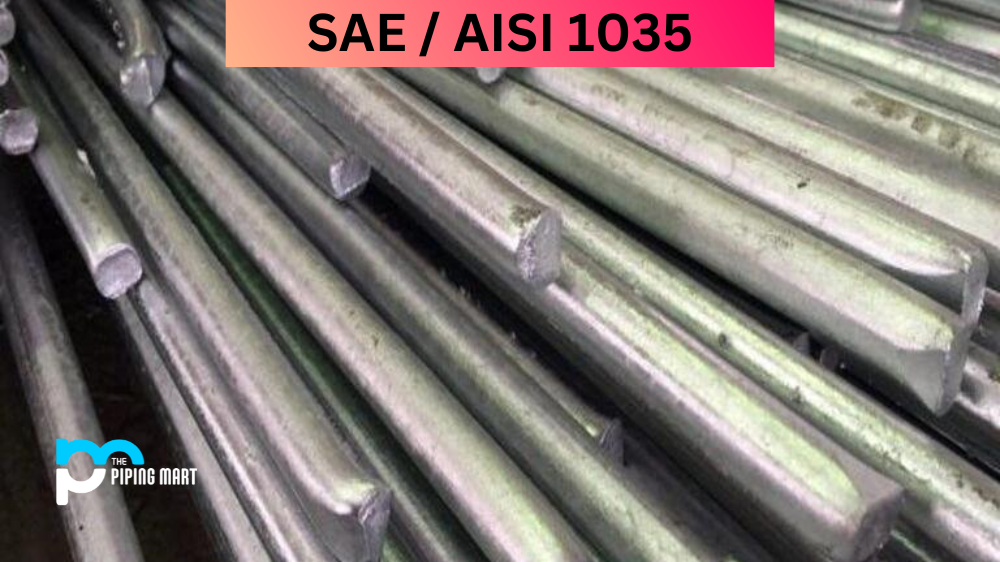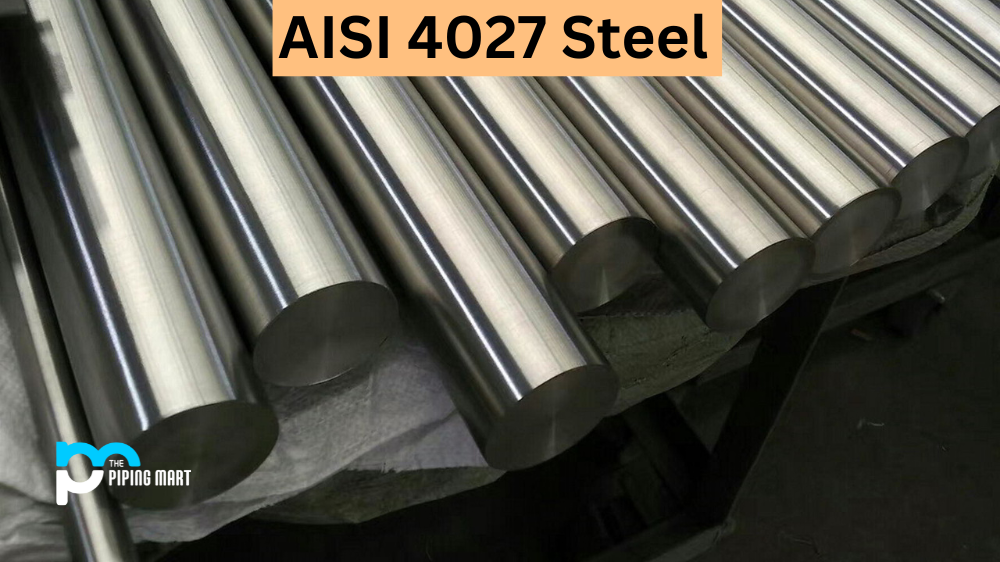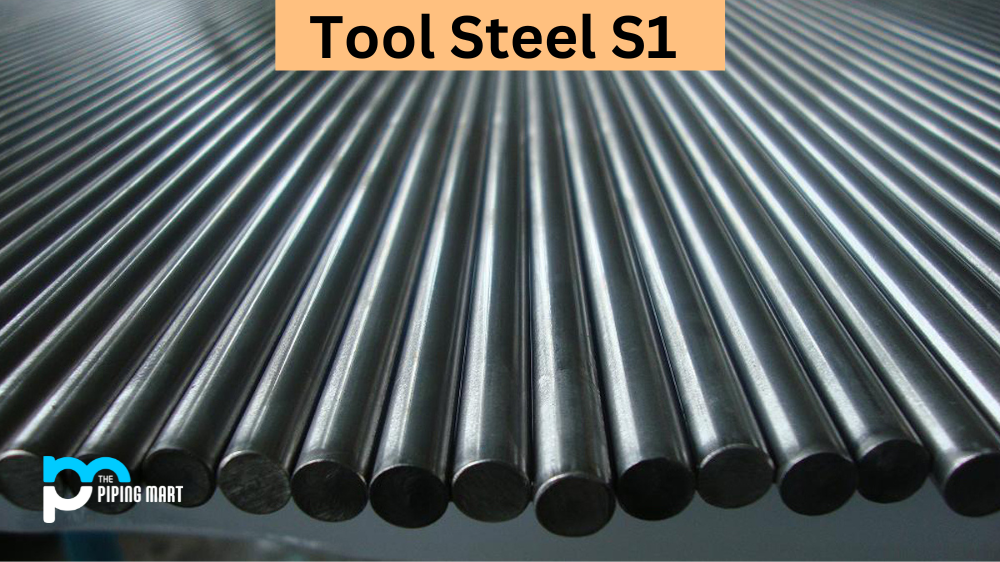Strengthened with small amounts of carbon, SAE/AISI 1035 is medium-carbon steel that is used in a wide variety of applications. It can be easily machined and heat-treated, making it suitable for many types of projects. In this blog post, we will go through the composition, mechanical properties, physical properties, uses, corrosion resistance, heat resistance, heat treatment and machining processes of SAE/AISI 1035.
SAE 1035 Composition
AISI 1035 carbon steel is composed mainly of iron (Fe) and carbon (C). Its chemical composition includes 0.32-0.38% Carbon (C), 0.60-0.90% Manganese (Mn), 0.04% (max) Phosphorus (P), 0.05% (max) Sulphur (S), and the base metal Iron (Fe).
| Element | Content (%) |
|---|---|
| Iron, Fe | 98.63-99.09 |
| Manganese, Mn | 0.60-0.90 |
| Carbon, C | 0.310-0.380 |
| Sulfur, S | ≤ 0.050 |
| Phosphorous, P | ≤ 0.040 |
SAE 1035 Mechanical Properties
SAE 1035 steel has a fairly low electrical conductivity among wrought carbon or non-alloy steels and average machinability and ductility. With a tensile strength of 500-550MPa and an ultimate yield strength of 335MPa, it has good cold workability, such as bending or forming operations with limited spring back when compared to other materials like aluminium or copper alloys.
| Properties | Metric | Imperial |
|---|---|---|
| Tensile strength, ultimate | 585 MPa | 84800 psi |
| Tensile strength, yield | 370 MPa | 53700 psi |
| Modulus of elasticity | 190-210 GPa | 29700-30458 ksi |
| Bulk modulus (typical for steel) | 140 GPa | 20300 ksi |
| Shear modulus (typical for steel) | 80 GPa | 11600 ksi |
| Poissons ratio | 0.27-0.30 | 0.27-0.30 |
| Elongation at break (in 50 mm) | 30% | 30% |
| Reduction of area | 53% | 53% |
| Hardness, Brinell | 183 | 183 |
| Hardness, Knoop (converted from Brinell hardness) | 204 | 204 |
| Hardness, Rockwell B (converted from Brinell hardness) | 89 | 89 |
| Hardness, Vickers (converted from Brinell hardness) | 192 | 192 |
| Machinability (based on AISI 1212 steel. as 100 machinability) | 65 | 65 |
SAE 1035 Physical Properties
Grade 1035 has an elongation at a break between 19-23%, meaning that it can be stretched up to 23% without breaking before returning to its original shape when released from tension forces. It also has a Brinell hardness between 119-235HBW which means it can be cold worked easily by using conventional tools but cannot be hardened through heat treatment due to its lower alloying content than higher grade steels such as AISI 1141 or AISI 4140 etc. The Poisson’s ratio measures the contraction strain per unit longitudinal strain, which is around 0.29 for this material under static loading conditions making it slightly more resistant than aluminium alloys which are commonly used in industries where weight savings are important, like automotive or aerospace sectors etc.
| Properties | Metric | Imperial |
|---|---|---|
| Density | 7.85 g/cm3 | 0.284 lb/in3 |
SAE 1035 Thermal Properties
| Thermal Properties | Metric | Imperial |
|---|---|---|
| Thermal expansion co-efficient (@20°C/68°F) | 11 µm/m°C | 6.11 µin/in°F |
| Thermal conductivity | 51.9 W/mK | 360 BTU in/hr.ft2.°F |
SAE 1035 Equivalent
| AMS 5080 | ASTM A544 (1035) | MIL S-19434 | AFNOR CC 35 | B.S. 080 A 37 |
| AMS 5082 | ASTM A545 (1035) | MIL S-3289 | DIN 1.0501 | B.S. 080 M 36 |
| ASTM A29 (1035) | ASTM A546 (1035) | MIL S-46070 | UNI C 35 | AMS 5080D |
| ASTM A510 (1035) | ASTM A576 (1035) | QQ S700 (C1035) | SS 1550 | AMS 5082A |
| ASTM A512 (1035) | ASTM A682 (1035) | SAE J1397 (1035) | B.S. 060 A 35 | ASTM A108 |
| ASTM A513 (1035) | ASTM A827 | SAE J403 (1035) | B.S. 080 A 32 | QQ S635 |
| ASTM A519 (1035) | ASTM A830 | SAE J412 (1035) | B.S. 080 A 35 |
SAE 1035 Uses
Alloy 1035 is typically used in applications such as fasteners, gears, shafts, axles, bolts and nuts in various industrial segments, including energy production equipment like turbines & generators; power transmission components like couplings & universal joints; automotive components like crankshafts & suspension parts; agricultural equipment parts; aircraft landing gears; truck frames & engine components; mining equipment parts etc. Its corrosion resistance capabilities make it useful in marine environments, too, where saltwater exposure is common for ships & boats etc.
Welding
Welding SAE / AISI 1035 requires proper preheating and post-heating processes due to its higher carbon content compared to other low alloy steels. When welding with a shielded metal arc welding process, one should use electrodes with low hydrogen content, while gas metal arc welding requires argon-based shielding gases, which helps minimize porosity issues due to oxidation caused by air present during the welding process if not properly prevented beforehand using inert gases. As mentioned earlier, this material does not require any special heat treatment after the welding process, so that makes it easier for those who want just weld without any further processing involved saving them time & resources along with money.
Corrosion Resistance
The corrosion resistance of SAE / AISI 1035 is quite impressive, making it an ideal material for environments where there is a high risk of rusting and corrosion. This grade of steel consists of carbon that has been alloyed with copper, nickel, and chromium to increase its strength and make it extremely resistant to oxidation. It can be found in some applications requiring a combination of durability and a good wear-resistant finish, such as automotive parts, machine components, fasteners, and structural components. 1035 also offers impact strength superior to standard grades of this type. Its great corrosion resistance makes it the perfect choice for areas with exposure to saltwater or other corrosive elements.
Heat Resistance
When heat is a factor, SAE / AISI 1035 steel has been proven to be one of the most reliable materials available. Its resistance to high temperatures and its ability to maintain its shape, structure, and strength in extreme conditions make it an ideal option for applications that require long-term durability. This steel type also boasts excellent ductility and impact toughness – crucial properties when it comes to withstanding thermal shock – allowing for greater design flexibility. Its impressive combination of tensile strength, stiffness, and formability opens up a host of potential uses in environments where heat resistance is key.
Heat Treatment
The heat treatment process of SAE/AISI 1035 steel is a critical part of the manufacturing process in order to ensure reliable performance. Heat treating it increases its ductility and strength and helps to prevent cracking and warping when used in applications that require higher tensile strength. During the process, temperature levels must be strictly monitored – too high or too slow temperatures can adversely affect the steel’s mechanical properties. In order to get the best performance from heat-treating SAE/AISI 1035 steel, a qualified engineer should be consulted for advice on any specific application. Proper maintenance and regular inspection after heat treatment can help preserve its integrity over long periods of time, ensuring its quality stays high.
Machining
Machining AISI/SAE 1035 steel is an excellent process for cutting and shaping this mild steel alloy. Those venturing into the machining of the alloy should be aware that it responds well to both cutting and heat treatment processes. For these reasons, it is ideal for projects that require moderate strength and toughness without sacrificing bendability or weldability. With the help of a high-speed milling machine and ample precautions taken to ensure safety and accuracy, one can work with AISI/SAE 1035 steel with minimal effort to shape it as desired. An understanding of this material can open up a wealth of possibilities for fabrication jobs down the line!
Conclusion
SAE / AISI 1035 is an excellent choice for multiple applications due to its desirable chemical composition and mechanical properties, such as good ductility, machinability, cold workability, corrosion resistance, and heat resistance. This material can be easily welded using both shielded metal arc welding process or gas metal arc welding process while still retaining its mechanical properties even after the welding process if proper preheating & post-heating processes are followed accordingly according to the manufacturer’s instructions. Overall this material offers great value when compared with other materials available on the market today, making it worth considering if looking for an economical yet reliable solution for your next project needs.

A passionate metal industry expert and blogger. With over 5 years of experience in the field, Palak brings a wealth of knowledge and insight to her writing. Whether discussing the latest trends in the metal industry or sharing tips, she is dedicated to helping others succeed in the metal industry.




